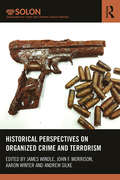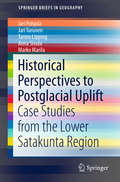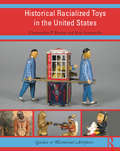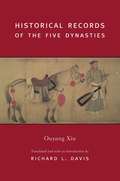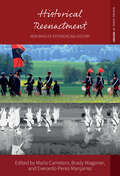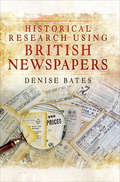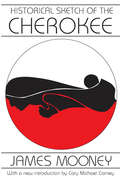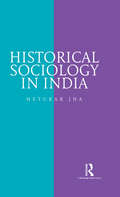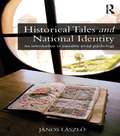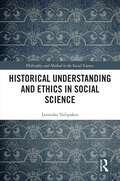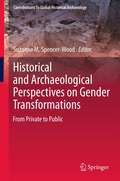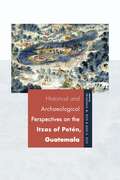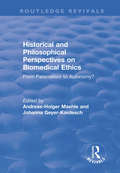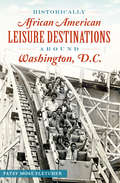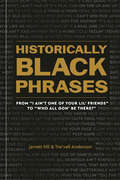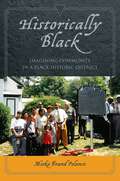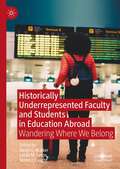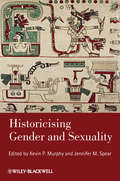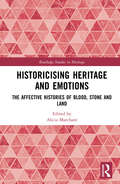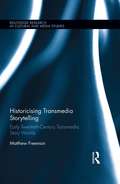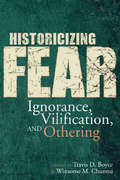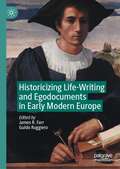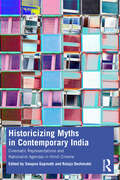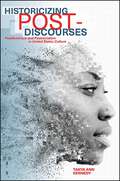- Table View
- List View
Historical Perspectives on Organized Crime and Terrorism (Routledge SOLON Explorations in Crime and Criminal Justice Histories)
by Andrew Silke Aaron Winter John F. Morrison James WindleIn recent years, in the context of the War on Terror and globalization, there has been an increased interest in terrorism and organized crime in academia, yet historical research into such phenomena is relatively scarce. This book resets the balance and emphasizes the importance of historical research to understanding terrorism and organized crime. This book explores historical accounts of organized crime and terrorism, drawing on research from around the world in such areas as the USA, UK, Ireland, France, Colombia, Somalia, Burma, Turkey and Trinidad and Tobago. Combining key case studies with fresh conceptualizations of organized crime and terrorism, this book reinvigorates scholarship by comparing and contrasting different historical accounts and considering their overlaps. Critical ‘lessons learned’ are drawn out from each chapter, providing valuable insights for current policy, practice and scholarship. This book is an indispensable guide for understanding the wider history of terrorism and organized crime. It maps key historical changes and trends in this area and underlines the vital importance of history in understanding critical contemporary issues. Taking an interdisciplinary approach and written by leading criminologists, historians and political scientists, this book will be of particular interest to students of terrorism/counter-terrorism, organized crime, drug policy, criminology, security studies, politics, international relations, sociology and history.
Historical Perspectives to Postglacial Uplift: Case Studies from the Lower Satakunta Region (SpringerBriefs in Geography)
by Jari Pohjola Jari Turunen Tarmo Lipping Anna Sivula Marko MarilaThis Brief discusses a unique mechanism to combine historical and archaeological evidence with statistical geodynamic modeling to study the historical development of the Eura region in lower Satakunta, Finland; this region is known for its rich cultural history. The book presents methods to model postglacial land uplift and the historical landscape. By using coupled data, it is possible to narrow the dating estimates of the archaeologically important places and structures and to build a more detailed reconstruction of landscape evolution in connection with the knowledge about human settlements and their movements. The resulting geospatial and uplift models are included as supplements.The primary audience for this book is experts and professionals working in the fields of archaeology, geography, geology and geospatial data analysis.
Historical Racialized Toys in the United States (Guides To Historical Artifacts Ser. #7)
by Christopher P. Barton Kyle SomervilleThis book explores the history of children’s toys and games bearing racial stereotypes, and the role these objects played in the creation and maintenance of structures of racialism and racism in the United States, from approximately 1865 to the 1930s. This time period is one in which the creation of structures of childhood and children’s socialization into race was fostered. Additionally, commodities, like toys, were didactic and disciplinary media in the creation, modification and reproduction of Victorian society. This volume: will shed light on issues of identity, ideology, and hegemony; will appeal to those interested in historical archaeology, critical theory, and constructions of racism and class, as well as material culture scholars, and antiques collectors; will be suitable for upper-level courses in historical archaeology, modern American history, and material culture studies.
Historical Records of the Five Dynasties
by Richard L. Davis Ouyang XiuWritten by Ouyang Xiu (1007-1072), an intellectual giant of the Song dynasty, Historical Records of the Five Dynasties offers a compelling interpretation of the Five Dynasties period (907-979). In overhauling the existing official history, Ouyang Xiu made several notable decisions. He recast the entire narrative in the popular "ancient" style to make for a rare fluency. He adopted rigorous moral categories to evaluate historical figures, reflecting the new regimen of his day. He also annotated portions of the text to establish a methodology for future writers. The Historical Records thereby became the official version-the last of China's dynastic histories to be written by an individual in a private capacity. In addition to its provocative commentary and lucid presentation, Historical Records is an eloquent statement on the art and craft of historical writing in the eleventh century.
Historical Reenactment: New Ways of Experiencing History (Making Sense of History #44)
by Mario Carretero, Brady Wagoner, and Everardo Perez-ManjarrezLong dismissed as the domain of hobbyists and obsessives, historical reenactment—the dramatization of past events using costumed actors and historical props—has only in recent years attracted serious attention from scholars. Drawing on examples from around the world, Historical Reenactment offers a fascinating, interdisciplinary exploration of this cultural phenomenon. With particular attention to reenactment’s social and pedagogical dimensions, it develops a robust definition of what the practice constitutes, considers what methodological approaches are most appropriate, and places it alongside museums and memorial sites as an object of analysis.
Historical Research Using British Newspapers
by Denise BatesThanks to digitisation, newspapers from the seventeenth to the twenty-first century have become an indispensable and accessible source for researchers. Through their pages, historians with a passion for a person or a place or a time or a topic can rediscover forgotten details and gain new insights into the society and values of bygone ages.Historical Research Using British Newspapers provides plenty of practical advice for anyone intending to use old newspapers by: * outlining the strengths of newspapers as source material * revealing the drawbacks of newspapers as sources and giving ways to guard against them * tracing the development of the British newspaper industry * showing the type of information that can be found in newspapers and how it can be used * identifying the best newspapers to start with when researching a particular topic * suggesting methods to locate the most relevant articles available * demonstrating techniques for collating, analysing and interpreting information * showing how to place newspaper reports in their wider contextIn addition nine case studies are included, showing how researchers have already made productive use of newspapers to gain insights that were not available from elsewhere.
Historical Sketch of the Cherokee
by James MooneyWhen James Mooney lived with and studied the Cherokee between 1887 and 1900, they were the largest and most important Indian tribe in the United States. His dispassionate account of their history from the time of their fi rst contact with whites until the end of the nineteenth century is more than a sequence of battles won and lost, treaties signed and broken, towns destroyed and people massacred. There is humanity along with inhumanity in the relations between the Cherokee and other groups, Indian and non-Indian; there is fortitude and persistence balanced with disillusionment and frustration. In these respects, the history of the Cherokee epitomizes the experience of most Native Americans. The Cherokee Nation ceased to exist as a political entity seven years after the initial study was done, when Oklahoma became a state.
Historical Sociology in India
by Hetukar JhaThis book is a comprehensive study of historical sociology and its development, especially in the Indian context. It looks at the works of Indian sociologists and analyses their approaches in terms of book-view (normative) and field-view (descriptive) history. The volume:� critically appraises reports of empirical surveys conducted during early colonial rule � including those by H. T. Colebrooke, Francis Buchanan, William Adam;� engages with the works of sociologists such as M. N. Srinivas, Ramkrishna Mukherjee, Louis Dumont, Nicholas Dirks, Bernard Cohn, Yogendra Singh, D. N. Dhanagare, A. M Shah, T. K. Oommen, among others; and� shows how historical perspective has been adopted in understanding aspects of Indian society � villages, castes, traditions, socio-cultural change, education, peasants and their movements, etc.Presenting an alternative idea of social reality, this book will deeply interest students and scholars of sociology, social theory, and social history.
Historical Tales and National Identity: An introduction to narrative social psychology
by János LászlóSocial psychologists argue that people’s past weighs on their present. Consistent with this view, Historical Tales and National Identity outlines a theory and a methodology which provide tools for better understanding the relation between the present psychological condition of a society and representations of its past. Author Janos Laszlo argues that various kinds of historical texts including historical textbooks, texts derived from public memory (e.g. media or oral history), novels, and folk narratives play a central part in constructing national identity. Consequently, with a proper methodology, it is possible to expose the characteristic features and contours of national identities. <P><P>In this book Laszlo enhances our understanding of narrative psychology and further elaborates his narrative theory of history and identity. He offers a conceptual model that draws on diverse areas of psychology - social, political, cognitive and psychodynamics - and integrates them into a coherent whole. In addition to this conceptual contribution, he also provides a major methodological innovation: a content analytic framework and software package that can be used to analyse various kinds of historical texts and shed new light on national identity. In the second part of the book, the potential of this approach is empirically illustrated, using Hungarian national identity as the focus. The author also extends his scope to consider the potential generalizations of the approach employed. <P><P>Historical Tales and National Identity will be of great interest to a broad range of student and academic readers across the social sciences and humanities: in psychology, history, cultural studies, literature, anthropology, political science, media studies, sociology and memory studies.
Historical Understanding and Ethics in Social Science (Philosophy and Method in the Social Sciences)
by Leonidas TsilipakosCan social scientific description capture the historically individual? Is the idea of an ethically committed social science morally defensible? This book offers a critical, historically-grounded perspective on these perennial methodological and ethical problems, in their current forms. It provides a series of in-depth examinations of recent work by prominent authors in sociology and philosophy. The book draws on the thought of Peter Winch to provide a coherent response to the core issues that underlie past and present debate in social science and to provide a solid basis for future inquiry. It will be of particular interest to social scientists, philosophers, and historians, and to anyone seeking a clear grasp of the demands made by historical understanding and ethics on the study of society.
Historical and Archaeological Perspectives on Gender Transformations
by Suzanne M. Spencer-WoodIn many facets of Western culture, including archaeology, there remains a legacy of perceiving gender divisions as natural, innate, and biological in origin. This belief follows that men are naturally pre-disposed to public, intellectual pursuits, while women are innately designed to care for the home and take care of children. In the interpretation of material culture, accepted notions of gender roles are often applied to new findings: the dichotomy between the domestic sphere of women and the public sphere of men can color interpretations of new materials. In this innovative volume, the contributors focus explicitly on analyzing the materiality of historic changes in the domestic sphere around the world. Combining a global scope with great temporal depth, chapters in the volume explore how gender ideologies, identities, relationships, power dynamics, and practices were materially changed in the past, thus showing how they could be changed in the future.
Historical and Archaeological Perspectives on the Itzas of Petén, Guatemala
by Prudence M. Rice and Don S. RiceHistorical and Archaeological Perspectives on the Itzas of Petén, Guatemala is the first exhaustively detailed and thorough account of the Itzas—a Maya group that dominated much of the western lowland area of tropical forest, swamps, and grasslands in Petén, Guatemala. Examining archaeological and historical evidence, Prudence Rice and Don Rice present a theoretical perspective on the Itzas’ origins and an overview of the social, political, linguistic, and environmental history of the area; explain the Spanish view of the Itzas during the Conquest; and explore the material culture of the Itzas as it has been revealed in recent surveys and excavations. The long but fragmented history of the Petén Itzas requires investigation across multiple periods and regions. Chapters in this six-part overview interweave varying data pertaining to this group—archaeological, artifactual, indigenous textual, Spanish historical—from multiple languages and academic fields, such as anthropology, archaeology, linguistics, ecology, and history. Part I introduces the lowland Itzas, northern and southern, with an emphasis on those of the central Petén lakes area. Part II discusses general Itza origins and identities in the Epiclassic period, while part III reviews Spanish perceptions and misconceptions of the Petén Itzas in their Contact-period writings. With these temporal anchors, parts IV and V present the archaeology and artifacts of the Petén Itzas, including pottery, architecture, and arrow points, from varied sites and excavations but primarily focusing on the island capital of Tayza/Nojpetén. Part VI summarizes key data and themes of the preceding chapters for a new understanding of the Petén Itzas. A companion volume to The Kowoj—a similar treatment of the Petén Itzas’ regional neighbors—Historical and Archaeological Perspectives on the Itzas of Petén, Guatemala demonstrates the unique physical, cultural, and social framework that was home to the Petén Itza, along with their backstory in northern Yucatán. Archaeologists, historians, art historians, and geographers who specialize in the Maya and the Postclassic, Contact, and Colonial periods will find this book of particular interest. Contributors: Mark Brenner, Leslie G. Cecil, Charles Andrew Hofling, Nathan J. Meissner, Timothy W. Pugh, Yuko Shiratori
Historical and Multicultural Encyclopedia of Women's Reproductive Rights in the United States
by Judith A. BaerMany brief articles about womens reproductive rights in the U.S.
Historical and Philosophical Perspectives on Biomedical Ethics: From Paternalism to Autonomy? (Routledge Revivals)
by Andreas-Holger Maehle Johanna Geyer-KordeschThis title was first published in 2002: This volume discusses the subject of biomedical ethics. Various views, historical and contemporary, are discussed, with the editors using the contrasting concepts in the shift from paternalism to autonomy in 20th-century medicine as a heuristic tool for the critical study of ethics in medicine.As far as the evidence in this volume goes, paternalistic medical practices and patient autonomy had an uneasy relationship by the beginning of the 20th century. A hundred years later, full autonomy in decisions on medical treatment is still subject to numerous caveats. The text pays close attention to the interplay between various players, noting how factors such as social contexts, governmental organizations and the biotechnological industry influence and shape responses to the principle of bioethics.
Historically African American Leisure Destinations Around Washington, D.C. (American Heritage)
by Patsy Mose FletcherFrom the late nineteenth to the mid-twentieth century, African Americans in the Washington, D.C. area sought leisure destinations where they could relax without the burden of racial oppression. Local picnic parks such as Eureka and Madre's were accessible by streetcars. Black-owned steamboats ferried passengers seeking sun and sand to places like Collingwood Beach, and African American families settled into quiet beach-side communities along the Western Shore of Maryland. Author and public historian Patsy M. Fletcher reveals the history behind Washington's forgotten era of African American leisure.
Historically Black Phrases: From "I Ain't One of Your Lil' Friends" to "Who All Gon' Be There?"
by jarrett hill Tre'vell AndersonA fun and thoughtful dictionary of Black language you didn&’t know you needed, Historically Black Phrases is a love letter to the Black community and the ways it drives culture.&“This perfect blend of explanation, definition and social commentary will have you laughing while learning.&”—George M. Johnson, New York Times bestselling author of All Boys Aren't Blue and We Are Not BrokenBlack vernacular doesn&’t often get its due—despite its enormous influence on mainstream culture—but Historically Black Phrases is here to give Black language its flowers. A celebration of more than two hundred staples of Black conversation—from church sayings and units of measure to compliments and reprimands—this sharp and witty guide explores the unique importance of Black expression and communication. Historically Black Phrases offers definitions and notable pop culture moments, as well as tips on pronunciation and usage of phrases like &“feelin&’ yourself,&” &“don&’t get it twisted,&” and &“pop off.&” In addition to the phrases, short essays offer insight on different facets of Black language from scholars, entertainers, and pop culture commentators (i.e., everybody and they mama). Authors, journalists, and hosts of the award-winning podcast FANTI, jarrett hill and Tre&’vell Anderson examine each phrase with humor and cultural precision, making Historically Black Phrases a vital ode to how Black language influences the world.
Historically Black: Imagining Community in a Black Historic District
by Mieka Brand PolancoQuestions the way we understand the idea of community through an investigation of the term "historically black"In Historically Black, Mieka Brand Polanco examines the concept of community in the United States: how communities are experienced and understood, the complex relationship between human beings and their social and physical landscapes—and how the term “community” is sometimes conjured to feign a cohesiveness that may not actually exist. Drawing on ethnographic and historical materials from Union, Virginia, Historically Black offers a nuanced and sensitive portrait of a federally recognized Historic District under the category “Ethnic Heritage—Black.”Since Union has been home to a racially mixed population since at least the late 19th century, calling it “historically black” poses some curious existential questions to the black residents who currently live there. Union’s identity as a “historically black community” encourages a perception of the town as a monochromatic and monohistoric landscape, effectively erasing both old-timer white residents and newcomer black residents while allowing newer white residents to take on a proud role as preservers of history.Gestures to “community” gloss an oversimplified perspective of race, history and space that conceals much of the richness (and contention) of lived reality in Union, as well as in the larger United States. They allow Americans to avoid important conversations about the complex and unfolding nature by which groups of people and social/physical landscapes are conceptualized as a single unified whole. This multi-layered, multi-textured ethnography explores a key concept, inviting public conversation about the dynamic ways in which race, space, and history inform our experiences and understanding of community.
Historically Underrepresented Faculty and Students in Education Abroad: Wandering Where We Belong
by Devin L. Walker Linda M. Lyons Seneca VaughtThis book examines how the unique perspectives of BIPOC faculty and students must be integrated into the undergraduate curriculum to expose students of color to education abroad experiences, enhance cultural awareness and sensitivity, and lend to a broader diversity and inclusion perspective. This edited volume, written by authors of color, argues that education abroad programs not only provide essential academic and cultural enrichment but can also be an important nexus of innovation. When approached within a creative, interdisciplinary, and holistic framework, these programs are ripe with opportunities to engage various constituencies and a potent source of strategies for bolstering diversity, recruitment, retention, and graduation. Despite a tendency to view study abroad as a luxurious option for persons with wealth and means, the editors and their authors argue that global education should be thought of as a fundamental and integral part of higher education, for all students, in a global era.
Historicising Gender and Sexuality (Gender and History Special Issues #9)
by Kevin P. Murphy Jennifer M. SpearHistoricising Gender and Sexuality features a diverse collection of essays that shed new light on the historical intersections between gender and sexuality across time and space. Demonstrates both the particularities of specific formulations of gender and sexuality and the nature of the relationship between the categories themselves Presents evidence that careful and contextualised analysis of the shifting relationship of gender and sexuality illuminates broader historical processes
Historicising Heritage and Emotions: The Affective Histories of Blood, Stone and Land
by Alicia MarchantHistoricising Heritage and Emotions examines how heritage is connected to and between people and places through emotion, both in the past and today. Discussion is focused on the overlapping categories of blood (families and bloodlines), stone (monuments and memorials) and land (landscape and places imbued with memories), with the contributing authors exploring the ways in which emotions invest heritage with affective power, and the transformative effects of this power in individual, community and cultural contexts. The 13 chapters that make up the volume take examples from the premodern and modern eras, and from two connected geographical regions, the United Kingdom, and Australia and the Pacific. Each chapter seeks to identify, historicise and contextualise the processes of heritage and the emotional regimes at play, locating the processes within longer historical and transnational genealogies and critically appraising them as part of broader cultural currents. Theoretically grounded in new approaches to the history of emotions and critical heritage studies, the analysis challenges the traditional scholarly focus on heritage in its modern forms, offering multifaceted premodern and modern case studies that demonstrate heritage and emotion to have complex and vibrant histories. Offering transhistorical and multidisciplinary discussion around the ways in which we can talk about, discuss, categorise and theorise heritage and emotion in different historical contexts, Historicising Heritage and Emotions is a valuable resource for students and scholars interested in heritage, emotions and history.
Historicising Transmedia Storytelling: Early Twentieth-Century Transmedia Story Worlds (Routledge Research in Cultural and Media Studies)
by Matthew FreemanTracing the industrial emergence of transmedia storytelling—typically branded a product of the contemporary digital media landscape—this book provides a historicised intervention into understandings of how fictional stories flow across multiple media forms. Through studies of the storyworlds constructed for The Wizard of Oz, Tarzan, and Superman, the book reveals how new developments in advertising, licensing, and governmental policy across the twentieth century enabled historical systems of transmedia storytelling to emerge, thereby providing a valuable contribution to the growing field of transmedia studies as well as to understandings of media convergence, popular culture, and historical media industries.
Historicizing Fear: Ignorance, Vilification, and Othering
by Travis D. Boyce Winsome M. ChunnuHistoricizing Fear is a historical interrogation of the use of fear as a tool to vilify and persecute groups and individuals from a global perspective, offering an unflinching look at racism, fearful framing, oppression, and marginalization across human history.The book examines fear and Othering from a historical context, providing a better understanding of how power and oppression is used in the present day. Contributors ground their work in the theory of Othering—the reductive action of labeling a person as someone who belongs to a subordinate social category defined as the Other—in relation to historical events, demonstrating that fear of the Other is universal, timeless, and interconnected. Chapters address the music of neo-Nazi white power groups, fear perpetuated through the social construct of black masculinity in a racially hegemonic society, the terror and racial cleansing in early twentieth-century Arkansas, the fear of drug-addicted Vietnam War veterans, the creation of fear by the Tang Dynasty, and more. Timely, provocative, and rigorously researched, Historicizing Fear shows how the Othering of members of different ethnic groups has been used to propagate fear and social tension, justify state violence, and prevent groups or individuals from gaining equality. Broadening the context of how fear of the Other can be used as a propaganda tool, this book will be of interest to scholars and students of history, anthropology, political science, popular culture, critical race issues, social justice, and ethnic studies, as well as the general reader concerned with the fearful framing prevalent in politics. Contributors: Quaylan Allen, Melanie Armstrong, Brecht De Smet, Kirsten Dyck, Adam C. Fong, Jeff Johnson, Łukasz Kamieński, Guy Lancaster, Henry Santos Metcalf, Julie M. Powell, Jelle Versieren
Historicizing Life-Writing and Egodocuments in Early Modern Europe
by James R. Farr Guido RuggieroThis volume historicizes the study of life-writing and egodocuments, focusing on early modern European reflections on the self, self-fashioning, and identity. Life-writing and the study of egodocuments currently tend to be viewed as separate fields, yet the individual as a purposive social actor provides significant common ground and offers a vehicle, both theoretical and practical, for a profitable synthesis of the two in a historical context. Echoing scholars from a wide-range of disciplines who recognize the uncertainty of the nature of the self, these essays question the notion of the autonomous self and the attendant idea of continuous identity unfolding in a unified personality. Instead, they suggest that the early modern self was variable and unstable, and can only be grasped by exploring selves situated in specific historical and social/cultural contexts and revealed through the wide range of historical documents considered here. The three sections of the volume consider: first, the theoretical contexts of understanding egodocuments in early modern Europe; then, the practical ways egodocuments from the period may be used for writing life-histories today; and finally, a wider range of historical documents that might be added to what are usually seen as egodocuments.
Historicizing Myths in Contemporary India: Cinematic Representations and Nationalist Agendas in Hindi Cinema
by Swapna Gopinath Rutuja DeshmukhThis book examines cinematic practices in Bollywood as narratives that assist in shaping the imagination of the age, especially in contemporary India. It examines historical films released in India since the new millennium and analyses cinema as a reflection of the changing socio-political and economic conditions at any given period. The chapters in Historicizing Myths in Contemporary India: Cinematic Representations and Nationalist Agendas in Hindi Cinemas also illuminate different perspectives on how cinematic historical representations follow political patterns and market compulsions, giving precedence to a certain past over the other, creating a narrative suited for the dominant narrative of the present. From Mughal-e-Azam to Padmaavat, and Bajirao Mastani to Raazi, the chapters show how creating history out of myths validate hegemonic identities in a rapidly evolving Indian society. The volume will be of interest to scholars of film and media studies, literature and culture studies, and South Asian studies.
Historicizing Post-Discourses: Postfeminism and Postracialism in United States Culture (SUNY series in Feminist Criticism and Theory)
by Tanya Ann KennedyHistoricizing Post-Discourses explores how postfeminism and postracialism intersect in dominant narratives of triumphalism, white male crisis, neoliberal and colonial feminism, and multiculturalism to perpetuate systemic injustice in America. By examining various locations within popular culture, including television shows such as Mad Men and The Wire; books such as The Help and Lean In; as well as Hollywood films, fan forums, political blogs, and presidential speeches, Tanya Ann Kennedy demonstrates the dominance of postfeminism and postracialism in US culture. In addition, she shows how post-discourses create affective communities through their engineering of the history of both race and gender justice.
